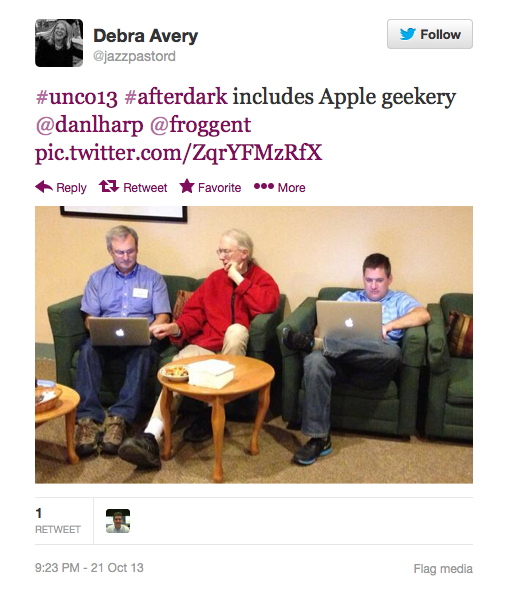A few last thoughts and observations from UNCO13 West:
— The worship services were very low church. UNCO worship reminded me a little bit of the very best youth and young adult worship in which I have participated in Unitarian Universalist circles — highly participatory, lots of singing and guitars and drums, often mildly chaotic and planned at the last minute — but UNCO worship services were led with more skill, and with far more theological depth.
— The worshipping community of UNCO welcomed kids wholeheartedly. Kids could play on the floor, or sit on parent laps, or vocalize, and no one minded. The service was not dumbed-down to kid level; there were no “moments for children,” no talking down to children during the sermon. Everyone accepted, with love, the autistic five year old who needed to run around (and occasionally be corralled by his parents) during the services. Yes, it could get a little chaotic, but between the love in the community, and the seriousness of purpose, it all worked out. I want to belong to a church that worships like this every week.
— Online connections and face-to-face connections were nicely woven together. I liked watching the Twitter feed which was projected at the front of the room during the plenary sessions; sure it got silly at times, but it also allowed for a much higher level of interaction than just having one person talking at a time. I also liked the combination of low-church and high-tech. (By the way, Megan told me that finding a location for UNCO is difficult because of the heavy technology demands — fast Internet service, plenty of bandwidth, lots of IP addresses, etc.)
— The unconference format worked well. Of course it worked well: most of the attendees at UNCO are clergy with advanced degrees, and with tons of experience in widely varied settings and ministries. Too often, I have seen clergy conferences built around expensive “experts,” who only give one approach to an issue, and who may in fact be less expert than one or more of the participants. (Which makes me want to say: Humility may be a virtue, but underestimating the expertise of oneself and one’s professional colleagues is foolish.)
— The unconference format does away with that jockeying for position that you see when planning traditional clergy conferences. In traditional clergy conferences, there can only be a few presenters; plan a traditional clergy conference, and watch as clergy jockey for position to try to land a precious slot as one of the presenters, or to try to get their favored “expert” called in as a presenter. The result: politics rather than relevance decides what gets presented; important viewpoints get left out; and the expertise of the participants is deprecated. (Alas, Unitarian Universalist clergy seem to prefer their outside experts and the associated hierarchical approach to clergy conferences; and I think they prefer their methodological rigidity, too;— don’t expect Unitarian Universalist clergy unconferences any time soon.)
— And finally, this Twitter exchange from two UNCO participants made the whole thing worthwhile: “Talking worship styles. That whole debate is a boomer debate, not a question for young adults.” (David L. Hansen) “Exactly. And it’s not helping to project it onto the Gen-X and Millennial generations.” (Anna Woofenden)
Back to the first post in the series
Megan took this photo of me racing B—— through the labyrinth during Kid UNCO. He won. (What can I say? Four year olds can turn corners better than adults.)



